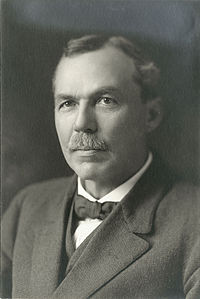- Jacob Piatt Dunn
-
Jacob Piatt Dunn Born 12 April 1855
Lawrenceburg, Indiana, USADied 6 June 1924 (aged 69)
Washington D.C., USAOccupation Historian and author Jacob Piatt Dunn (April 12, 1855 - June 6, 1924) was an American historian and author of several books. He was instrumental in making the Indiana Historical Society an effective group, serving as its secretary for decades. He was also instrumental in the Indiana Public Library Commission. As an ethnologist, his main concern was that of the Miami tribe of Indiana and the preservation of their language. His greater Indianapolis treatise was his most important work as an amateur historian. He also served as adviser to Indiana governor Thomas R. Marshall and Senator Samuel Ralston. He was responsible for a new Indianapolis city charter, and use of the Australian ballot law for the city (1889), even though he never ran for office.[1]
Contents
Life
Dunn was born in Lawrenceburg, Indiana on April 12, 1855. He moved with his parents to Indianapolis in 1861. He graduated with a Bachelors of Science at age 19 from Earlham College in 1874, and obtained a LL.B. from the University of Michigan two years later. He was a lawyer for a few years in Indianapolis after graduation, but would move to Colorado in 1879 for five years looking after the family's silver interests. While in Colorado he developed an interest in the history of Indians, and would serve as a reporter for newspapers in Denver, Colorado and Leadville, Colorado.[2]
He would return permanently to Indianapolis in 1884. He would release Massacres of the Mountains: a History of the Indian Wars of the Far West 1815-1875 in 1886. Relying heavily on government documents, it was the first scholarly attempt at the subject, winning him considerable fame for publishing such a "minor classic". Massacres to this day is held in high regard by those interested in the history of the American frontier. At this time Houghton Mifflin were working on a series of books called the American Commonwealths, and invited Dunn to write the Indiana volume of the series. In 1888 Dunn would write a book entitled Indiana: A Redemption from Slavery. He would further support himself by writing political editorials for local newspapers.[3]
Fame from his books elevated him in Indianapolis circles. In 1886 he joined two other Indianapolis historians in improving both the Indiana Historical Society and the Indiana Public Library. As recording secretary, he managed to make the Indiana Historical Society into an active society. He was chosen twice to be the Indiana state librarian, from 1889–1892, and would serve as charter president of the Indiana Public Library Commission from 1899 to 1914.[4]
He would be the most serious historian looking into the origin of the term "Hoosier" as a term used to describe citizens of Indiana.[5]
In 1910 he wrote the two volume Greater Indianapolis, considered to be his greatest work. The first volume was one of the best local histories ever published, and the second volume consisted of the biographies of notable residents of Indianapolis. With his five-volume Indiana and Indianans published in 1919, they are still considered premier sources for studying Indiana history. His other notable 20th century work was writing a dictionary of the language of the Miami Indians with the granddaughter of Chief Little Turtle, a language that has not survived the 20th century.[4][6]
In his last years, he would go to Haiti to mine for manganese for two months in 1921, and then serve as adviser for Samuel Ralston in 1922. As Ralston's chief aide, Dunn would die in Washington D.C. in 1924.[4]
Controversies
Some claim Dunn was an example of a blend between a secular evangelist and progressive, while others believe that Dunn was more of a "'hide-bound' partisan". Dunn's two biggest interests both ended unsuccessfully. The first was obtaining precious metals in the American West and Hispaniola. The second, and far more controversial, was his desire to alter the Indiana state constitution to remove voting privileges for many immigrants and blacks. Some modern historians fret over Dunn's description of such things as cannibalistic aboriginals and voodoo in Haiti, and his use of the terms nigger and chink. These historians question Dunn's sincerity on wanting to preserve the language of the Miamis.[6]
Selected works
References
- ^ Lane, James. Jacob Piatt Dunn Jr.: A Life in History and Politics, 1855-1924. by Ray E. Boomhower The Journal of American History, Vol. 85, No. 3. (Dec., 1998), p. 1116.
- ^ Bodenhamer, David. The Encyclopedia of Indianapolis (Indiana University Press, 1994) pg.515
- ^ Bodenhamer 515, 516
- ^ a b c Bodenhamer 516
- ^ Indiana Historical Society
- ^ a b Lane
External links
- Jacob Piatt Dunn (1888). Indiana. Houghton, Mifflin. http://books.google.com/books?id=GHYdAAAAMAAJ. at Google Books
- Jacob Piatt Dunn (2002). Massacres of the Mountains. Stackpole Books. ISBN 0811728137. http://books.google.com/books?id=vjdQ7sVCmHMC. at Google Books
Categories:- 1855 births
- 1924 deaths
- American historians
- Earlham College alumni
- Historians of Indiana
- History of Indianapolis, Indiana
- Historians of the United States
- People from Indianapolis, Indiana
- University of Michigan alumni
Wikimedia Foundation. 2010.

